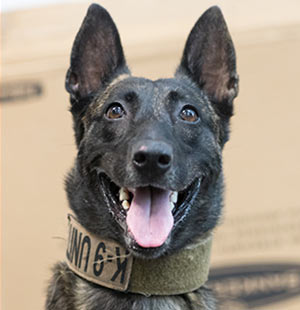The Nose Knows: K-9 Dogs Sniff out Danger
This is the second in an ongoing series, “A Different Breed of Officer,” featuring the St. Louis Fed’s K-9 program. We are profiling the dogs and handlers who dedicate their lives to keeping employees and visitors safe. (For security reasons, names are not used.)
Watching a Federal Reserve K-9 officer train to find explosives is an intense scene: The dog enters a cavernous room, sniffing vigorously.
She sweeps the cabinets, the floor, behind boxes and around any unfamiliar object. Her nostrils are on overdrive, so much so that Law Enforcement has a term for it: vacuuming.
When the dog finds the planted explosive, called the “hide,” you can see the satisfaction in her eyes—and those of her human handler, who rewards his proud partner with a toy.
“We have the tail wagging, and she’s in final position,” explained a St. Louis Fed officer during a recent training exercise. “This is her happy time. I’m actually surprised she’s not parading.”
A Trio of Terrific K-9s

Our St. Louis-based K-9s include a Belgian Malinois cross (left) and a shepherd Malinois (right). They have won recognition for their bomb-sniffing prowess.
The St. Louis Fed introduced K-9s to our Law Enforcement division in 2014. These include “Officer V,” a Belgian Malinois cross with a golden coat, and “Officer K,” a shepherd Malinois with a dark coat. Both dogs are 6 years old and based in St. Louis. Lucky visitors to our free Economy Museum downtown may catch a glimpse of them in action.

Our K-9 in Memphis, Tenn., is a Dutch shepherd with a big personality.
Meanwhile, at our Memphis Branch, “Officer P” is a Dutch shepherd that may be small in stature but is big on personality. Economic educators and other guests may catch this 2-year-old pup policing the facility.
The K-9 presence added yet another layer of security to the Fed, said a senior Law Enforcement official. One of the critical roles they play is detecting the presence of potential explosives.
“The dogs provide a more thorough and efficient method of explosives detection than either human or technological screening methods,” he said. “Our dogs are trained continuously and held to rigorous standards.”
Training: It’s an “Everyday Thing”
Keeping the dogs sharp is a priority for the handlers. Each K-9 team trains about 200 hours a year.
“We’re always doing new training. Our certification requires a certain number of hours, but really, it’s an everyday thing,” Officer K’s handler said. “Training is to keep their abilities strong so they recognize odor. And we train with large amounts [of hidden explosive scents] to really small amounts. It’s basically to keep them intrigued in the game.”
Officer V’s handler concurs: “It’s important to keep them engaged. Their job is to detect.”
At a glance:
- Our K-9s are certified through the North American Police Work Dog Association.
- The dogs can smell nine different odors at the same time.
- They and their handlers have won recognition in multiple bomb-sniffing competitions.
- On average, each dog screens about 15 inbound vehicles a day.
What It Takes to Be a K-9 Handler
Besides time on the job and in training, being a K-9 officer is a 24/7 commitment. It takes a tremendous amount of dedication to step into this demanding role, said the St. Louis Fed’s canine supervisor.
“You have to be committed, because the handler’s job doesn’t end at the end of the day: Their partner really does become part of their family,” he said. “A lot of resources go into training the officer and bonding them with the dog. Our officers are definitely both staying through these dogs’ careers, which can last eight to 10 years.”
But at the end of the day, it’s all worth it, said Officer P’s handler.
“When I give presentations to groups who come to the Memphis Branch, I let them know that my partner is here to help ensure that we keep the Bank and the people in it safe,” he said. “When she’s hard-headed, I wonder, Why did I ever get into this? But then she’ll come put her nose under my arm, stick her head in my elbow and force her way into a hug.”
Additional Resources
This blog explains everyday economics and the Fed, while also spotlighting St. Louis Fed people and programs. Views expressed are not necessarily those of the St. Louis Fed or Federal Reserve System.
Email Us


